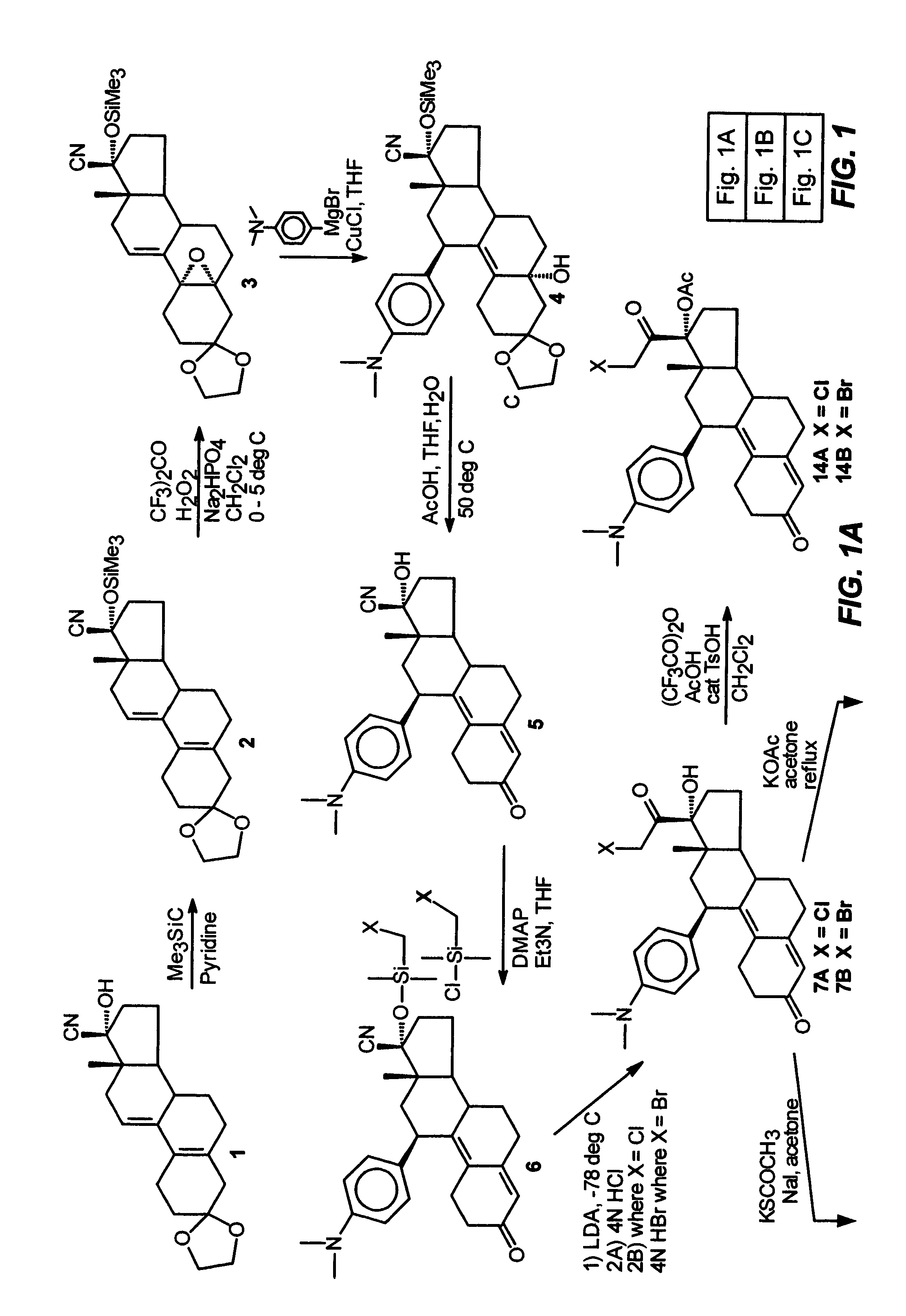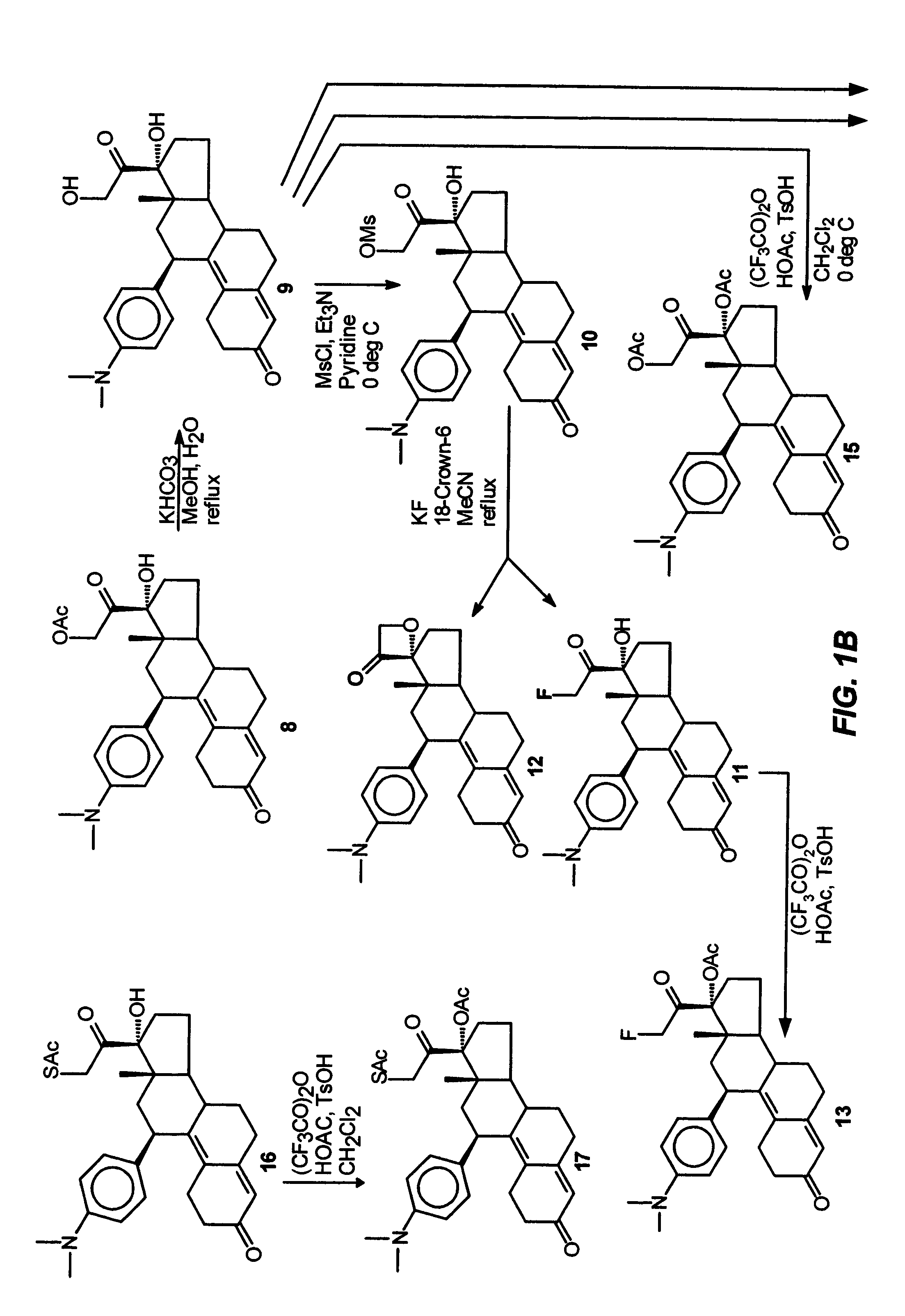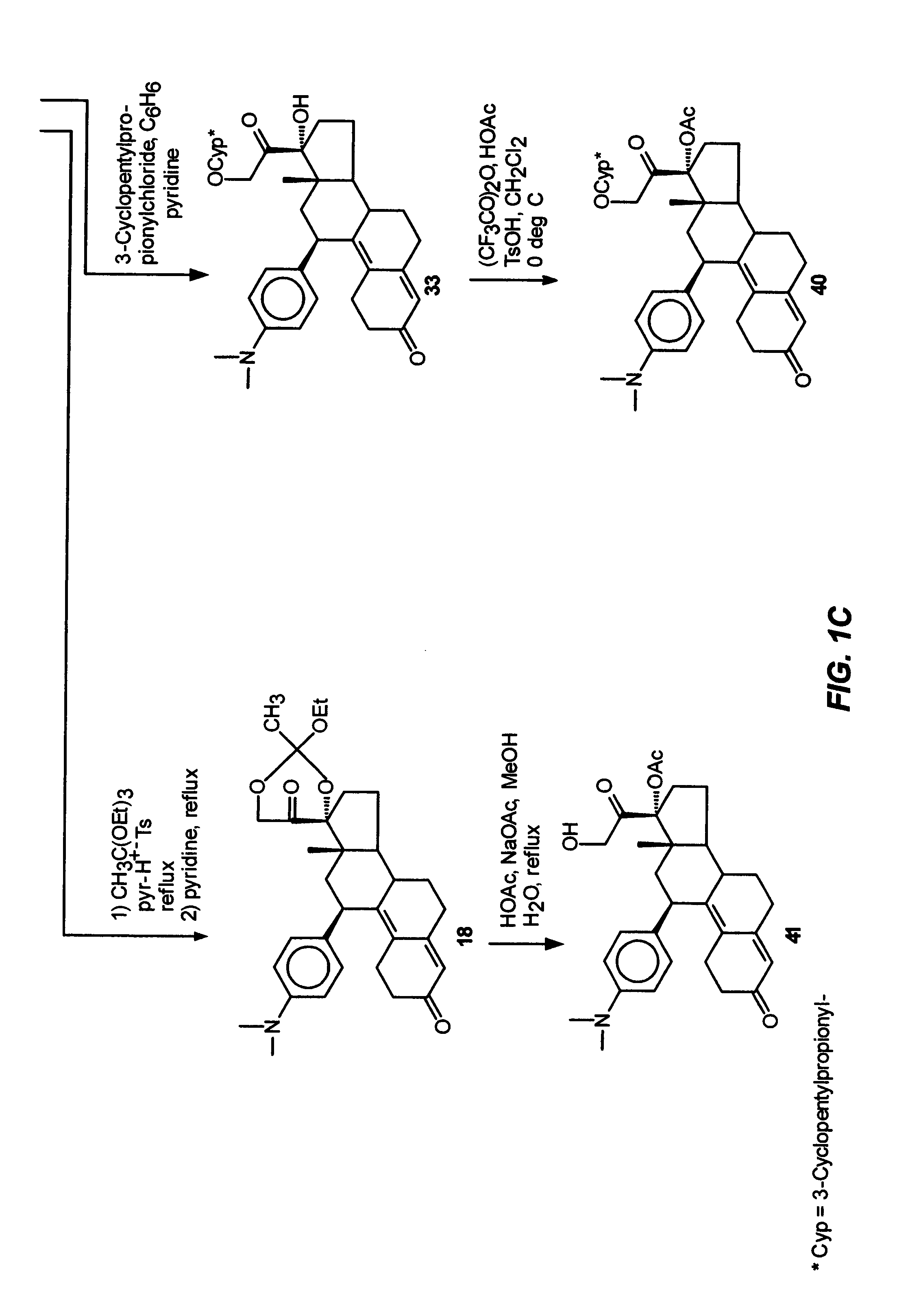Structural modification of 19-norprogesterone I: 17-α-substituted-11-β-substituted-4-aryl and 21-substituted 19-norpregnadienedione as new antiprogestational agents
a technology of antiprogesterone and structure modification, which is applied in the field of new antiprogesterone 17substituted, 11substituted4aryl and 21substituted 19-norpregnadienedione analogs, can solve the problems that the goal of achieving the goal of achieving antiglucocorticoid steroids has not yet been fully achieved, and achieves the effects of reducing the risk of uterine endo
- Summary
- Abstract
- Description
- Claims
- Application Information
AI Technical Summary
Benefits of technology
Problems solved by technology
Method used
Image
Examples
example 3
[0090]This example illustrates the preparation and properties of 17α-acetoxy-21-bromo-11β-[4-(N,N-dimethylamino)phenyl]-19-norpregna-4,9-diene-3,20-dione (4).
Step 1. Purification of 7B
[0091]The pure 21-bromo compound (B) was isolated from a 90:10 mixture of the 21-halo product (7B:7A) by means of Waters Prep LC system on a NovaPak C18 column (40×100 mm) eluted with 30% aq. MeOH and 0.03% Et3N at a flow rate of 35 mL / min and at λ=334 nm. A total amount of 0.75 g of a 90:10 mixture (7B:7A) was chromatographed in 10 runs of 75 mg each to give of 0.5 g of the pure 21-bromo compound (7B) as a pale yellow solid in 67% yield. This material was >99% pure by analytical HPLC. FTIR (KBr, diffuse reflectance) νmax 3327, 2948, 1723, 1660, 1611 and 1518 cm−1. NMR (CDCl3) δ 0.3 (s, 3H, C18-CH3), 2.80 (s, 6H, NMe2), 4.33 (dd, J=12 Hz, J2=9 Hz, 2H, C21-CH2Br), 4.40 (br d, 1H, C11α-CH), 5.65 (s, 1H, C4-CH═), 6.55 (d, J2=9 Hz, 2H, 3′, 5′ aromatic-CH's), 6.9 (d, J=9 Hz, 2′, 6′ aromatic-CH's).
Step 2. Pr...
example 4
[0093]This example illustrates the preparation and properties of 17α,21-diacetoxy-11β-[4-(N,N-dimethylamino)phenyl]-19-norpregna-4,9-diene-3,20-dione (15).
[0094]Under nitrogen, a mixture of trifluoroacetic anhydride (4.0 mL, 28.3 mmol), glacial acetic acid (1.6 mL, 27.7 mmol) and dry CH2Cl2 (10 mL) was stirred at room temperature for 30 min. and then cooled to 0° C. in an ice bath. p-Toluenesulfonic acid monohydrate (0.1 g, 0.53 mmol) was added followed by a solution of the 17α, 21-diol (9, 0.345 g, 0.77 mmol) in dry CH2Cl2 (2 mL). The reaction mixture was stirred at 0° C. and monitored by TLC (10% acetone / CH2Cl2) which indicated a complete reaction in two hrs. The mixture was diluted with H2O (10 mL), neutralized with concentrated NH4OH solution and extracted with CH2Cl2 (3×). The organic layers were washed with H2O (3×), combined, filtered through Na2SO4 and concentrated in vacuo to give 0.4 g of the residue as a foam. This material was purified by flash chromatography using 5% ac...
example 5
[0095]This example illustrates the preparation and properties of 17α-acetoxy-21-acetylthio-11β-[4-(N,N-dimethylamino)phenyl]-19-norpregna-4,9-diene-3,20-dione (7).
Step 1. 17α-Hydroxy-21-acetylthio-11β-[4-(N,N-dimethylamino)phenyl]-19-norpregna-4,9-diene-3,20-dione (16)
[0096]The 17α-Hydroxy-21-bromo compound (LB) (2.79 g, 5.44 mmol) dissolved in acetone (150 mL) was refluxed with sodium iodide (8.16 g, 54.4 mmol) for 1 hr in an atmosphere of nitrogen and then filtered directly into a suspension of potassium thioacetate (6.2 g, 54.4 mmol) in acetone (150 mL). After refluxing for an additional 2.5 hrs, the reaction mixture was cooled to room temperature, filtered, concentrated in vacuo, diluted with H2O and extracted with CH2Cl2. The organic fractions were washed with H2O and brine, combined and dried over sodium sulfate. The filtrate was evaporated and the residue was purified via flash silica gel column (6% acetone / CH2Cl2) to afford 1.99 g of 16 as a yellow foam in 72.1% yield. Cryst...
PUM
 Login to View More
Login to View More Abstract
Description
Claims
Application Information
 Login to View More
Login to View More - R&D
- Intellectual Property
- Life Sciences
- Materials
- Tech Scout
- Unparalleled Data Quality
- Higher Quality Content
- 60% Fewer Hallucinations
Browse by: Latest US Patents, China's latest patents, Technical Efficacy Thesaurus, Application Domain, Technology Topic, Popular Technical Reports.
© 2025 PatSnap. All rights reserved.Legal|Privacy policy|Modern Slavery Act Transparency Statement|Sitemap|About US| Contact US: help@patsnap.com



